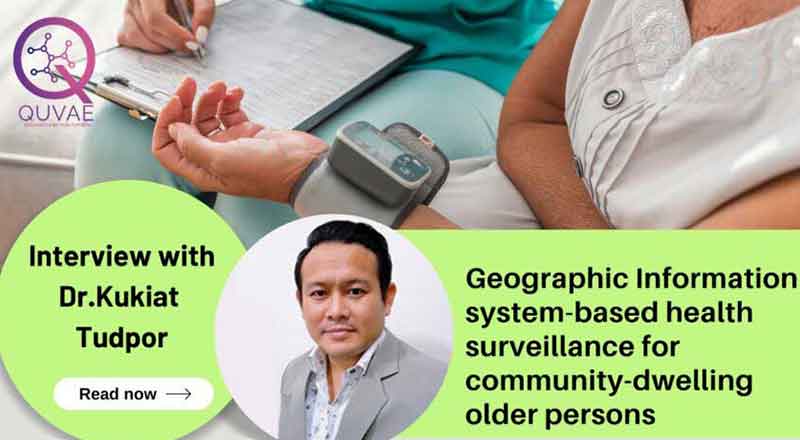Assistant Professor, Academic Consultant of QUVAE Thailand from Faculty of Public Health, Mahasarakham University, Thailand. Dr.Kukiat Tudpor is a member of alumni of Harvard Medical School, USA and Radboud University Nijmegen Medical Center, The Netherlands. Contact: [email protected]
Geographic information system-based health surveillance for community-dwelling older persons
1. Tell us about your motivations for taking up this study.
KK: Well, as a public health researcher working in rural communities, I have seen many community health volunteers who work for free. It’s gonna be very nice if we can help them in some ways. One of my colleagues said she can map the location for the volunteers and that’s how we started the project.
2. Tell us about a work situation that tested your ability to cope with problems or stress. The steps you took to overcome these obstacles.
KK: Working in the fieldwork is totally different from working in the lab. You have to deal with people with different backgrounds. Sometimes, you have to be flexible with the appointments when they postpone or cancel.
3. How difficult is it to monitor older people in rural areas, in your opinion?
KK: Good question. They won’t tell you everything about what they’ve done. So, it’s difficult to find the real sources of their health problems. Sometimes you have to ask their families or even their neighbors to get the truth. That’s why we have volunteers who are close to them. When they trust you enough, then they will tell you the truth.
4. Interested in studying public health? What inspired you to do so?
KK: Many treatment interventions and innovations are invented, but not all are used in the real world. Public health makes sure that all people have access the public services equally.
5. What experiences have you had advising clients or community groups on health-related topics, such as diet or exercise.
KK: Sure, I’m a physiotherapist and also studying nutrition. So, I advised older people with knee pain, basic joint stretching in case of paralysis as well as a diet for hypertension and diabetes people.
6. How a Geographical information system (GIS)-based system plays a significant role for health care in older persons in Thailand.
KK: The GIS is very precise. You can add the GIS information to the mobile application. Then you can monitor their health from anywhere. You can also analyze how the places they live can affect their health.
7. How village health volunteers (VHVs) play a crucial role in communicating ben older persons and health care professionals in Thailand.
KK: They are neighbors next door. So, they have a very close relationship with the community. These people are trained to monitor everything in the community. For example, they can count the number of jars or bowls in the households which are sources of mosquitos. Sometimes they also bring the patients to the hospital for free. They are super important. That’s why many groups of researchers approach them when they have new ideas for the community.
8. What are the outcome measures and data collection tools you proposed for this study?
KK: We collect a lot of things about health like tooth loss, fall frequency, stress levels, diseases like diabetes and hypertension. The distances between the older person’s houses and the hospital are also recorded.
9. How was the feedback and response from the participants when undertaking this research?
KK: They always say thank you when we are there for them. The volunteers are the groups of active people. So, they cooperate very well. The families of the older persons are also well participating.
10. In what way your proposed application was different from the existing 2,000 mobile health applications for dependent older persons.
KK: The app is designed based on the demand of older people and volunteers. After it’s invented, it will be tested by them. If they are satisfied, the app will be rechecked and adapted to their comments.
11. How your proposed mobile application design served health surveillance, support, promotion and prevention.
KK: With the mobile app, users can monitor the older’s health from a remote distance. The app also has video sources to improve the volunteer’s knowledge. They can also update the health information by themselves. This information will be cross-checked by the nurse from the local hospital. In this way, health promotion and disease prevention can be designed individually.

